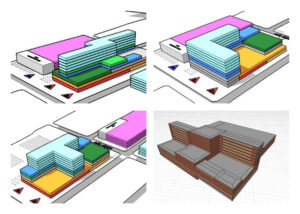Energy Modeling Creates Flexibility for Your Code Compliant Design
Energy models are one of the best tools for designing highly efficient, cost-effective buildings. They can provide design creativity and freedom while confirming that those designs can meet more stringent energy codes and other performance goals. Rather than only using them at the end of a project to document compliance with the energy codes, energy models are most effective when used early and often in the design process. This creates an iterative process for optimizing the design.
Energy modeling provides design teams with greater flexibility by enabling compliance through the Performance Pathway in IECC or ASHRAE 90.1. Depending on the project type, size, and climate zone, differences in mandatory requirements may influence which code is selected.
Once chosen, all disciplines must follow the same compliance path. While mandatory requirements still apply, energy models allow teams to demonstrate compliance by taking tradeoffs between design disciplines, when prescriptive measures cannot be met. The proposed design is modeled and then compared to an alternate version of the building design representing code minimums. The proposed design is then required to achieve a certain % reduction in energy to show the design is at least equivalent if not more efficient than the code minimum design. The stringency of that reduction varies for each performance pathway under IECC or ASHRAE 90.1.This flexible approach also supports AIA 2030 design targets, performance tracking, and broader goals such as Net Zero and sustainability certifications.
 Early phase massing analysis can provide insight into performance and energy code compliance well before design unfolds.
Early phase massing analysis can provide insight into performance and energy code compliance well before design unfolds.
Our team has provided highly valuable energy modeling for energy codes and green building standards on over 30 million square feet of commercial, healthcare, sports, education, government, and other complex building types. We target the needs of your project to protect your first cost investment and maximize ROI.
Continue Reading:
SSR’s team of energy and sustainability experts is ready to successfully guide you through the energy code compliance process. Contact us today!





